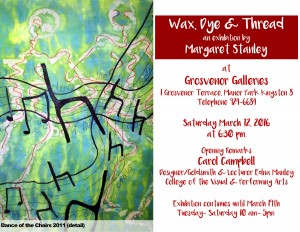
Margaret Stanley Tells Her Stories Through Wax, Dye and Thread
March 15th, 2016
The music of the late David Bowie floated across the garden. The evening was warm, with a little left-over breeze. We nibbled on humus and Solomon Gundy and crackers, and were then summoned to the house for the opening of Margaret Stanley’s new exhibition, Wax, Dye and Thread.
“The work in this exhibition was produced over the past six years,” comments Stanley. “Some has already been exhibited in small group shows. Some is new. I wanted to show it all together for two reasons. Firstly, the method of producing it was the same, I used wax, dye and stitching; and second, it was made in an important period of change in my life. The pieces explore the physical and emotional challenges which I experienced in the period before and after my retirement from full-time teaching in the Textile Department at Edna Manley College.”
The title disguises the underlying mood of the pieces, which are for the most part very personal. Wax, dye and thread are simply the tools the artist works with – although there is nothing simple about Stanley’s work. The added details are delicious. Shine Eye Girl, one of the three strong Jamaican women that adorn one of the walls, wears a sugar-pink wig and a pale blue satin ribbon round her waist. African Princess has big hoop earrings and green feathers. Roly Poly simply has amazing curves. There are “two little ones for Bowie,” as Stanley puts it: Put on your red shoes (from the song Let’s Dance) and Fashion from Bowie’s 1980 song of the same name. Hence the background music… The Bowie girls wear hats, at an angle. Stanley calls the series Versions – an alternative look at ‘Fashionistas’ in our Jamaican culture.” Stanley now teaches fashion illustration as well as textiles at the Edna Manley College of the Visual and Performing Arts. “I try to include a cultural approach to editorial projects,” she notes.
While the women are bright and sassy and witty, several of the works reflect personal challenges. As in all our lives, some problems are mundane in nature, if irritating; for example, the repeated issue for Stanley of keeping chairs in her studio that keep migrating elsewhere, called Dance of the Chairs. The spiky chairs dip and swing around among musical notes as they move around. With two pieces called Funnybones, Stanley depicts the “aches and pains of aging” as she calls it, in a tragicomic way. One figure is almost tiptoeing in pain, while its pursed red mouth says:“Not funny.“ Narrow threads pass through the limbs, a web of nerves. “I have tried to approach these challenges with humour, as that is what keeps me sane,” says Stanley, wryly.
Hope is more confusion and frustration than the fulfillment of wishes. Stanley says she created this during a difficult time at work, when she was “planting seeds, but they were not bearing.” Dead brown leaves adorn the yellow ochre background, and the West African Adinkra symbol for Hope floats around the edges.
So what gives Stanley hope and refreshment? As so many Jamaicans do, the true escape is to the beach. These regular escapes are documented in Blue Sea Dances, in the finest and most delicate of blues. These are overlapping pieces like waves, floating from the window frame in the evening breeze.
Artists must tell their own stories, and Stanley is deliberate and conscious of this, as she moves through stages and changes – both physical and emotional. “My work has developed and changed over the years, and I want to document this period, as I move forward to exploring new ideas,” she says.
The exhibition continues all this week.

Textile artist Margaret Stanley was born in Kingston and was educated and worked in the UK from 1969 – 1988. She returned to Jamaica to teach Textile Art at the Edna Manley College of the Visual and Performing Arts until retirement in 2013.
Tags: aging, art, beach, David Bowie, Edna Manley College for the Visual and Performing Arts, fashion illustration, Margaret Stanley, textile art
The Gleaner reserves the right not to publish comments that may be deemed libelous, derogatory or indecent.
To respond to The Gleaner please use the feedback form.
- We Are the Zoomers
- Living Online with Humans and Birds: NAOC 2020
- Human Trafficking and the Problem of Public Education
- Down Memory Lane
- Are We Ready to Recover from COVID-19?
- Road Safety Matters: Is Your Vehicle Safe?
- Sexual Harassment, Me Too, and the Minister’s Disturbing Giggle
- The Vulnerable Senior Citizens, Private Care Homes and COVID-19
- A Muddle Over Masks
- Here is Something Life-Saving You Can Do: Give Blood!



